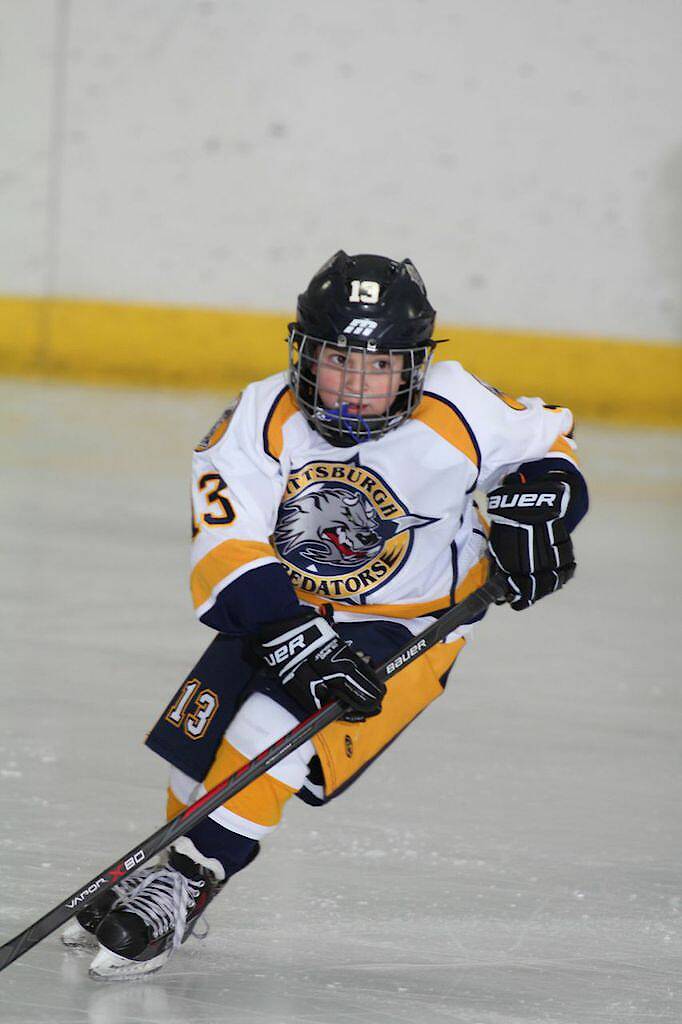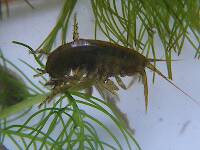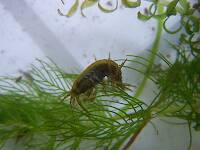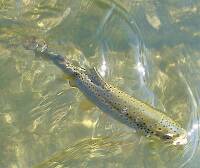
Hex Mayflies
Hexagenia limbata
The famous nocturnal Hex hatch of the Midwest (and a few other lucky locations) stirs to the surface mythically large brown trout that only touch streamers for the rest of the year.
Featured on the forum

As far as I can tell, this species has only previously been reported from one site in Oregon along the Columbia gorge. However, the key characteristics are fairly unmistakable in all except for one minor detail:
— 4 small yellow spots on frons visible in photos
— Narrow occipital spinule row curves forward (but doesn’t quite meet on stem of ecdysial suture, as it's supposed to in this species)
— Short spinules on anterior margin of front legs
— Short rposterior row of blunt spinules on abdominal tergae, rather than elongated spinules dorsally
I caught several of these mature nymphs in the fishless, tiny headwaters of a creek high in the Wenatchee Mountains.
— 4 small yellow spots on frons visible in photos
— Narrow occipital spinule row curves forward (but doesn’t quite meet on stem of ecdysial suture, as it's supposed to in this species)
— Short spinules on anterior margin of front legs
— Short rposterior row of blunt spinules on abdominal tergae, rather than elongated spinules dorsally
I caught several of these mature nymphs in the fishless, tiny headwaters of a creek high in the Wenatchee Mountains.

Troutnut is a project started in 2003 by salmonid ecologist Jason "Troutnut" Neuswanger to help anglers and
fly tyers unabashedly embrace the entomological side of the sport. Learn more about Troutnut or
support the project for an enhanced experience here.
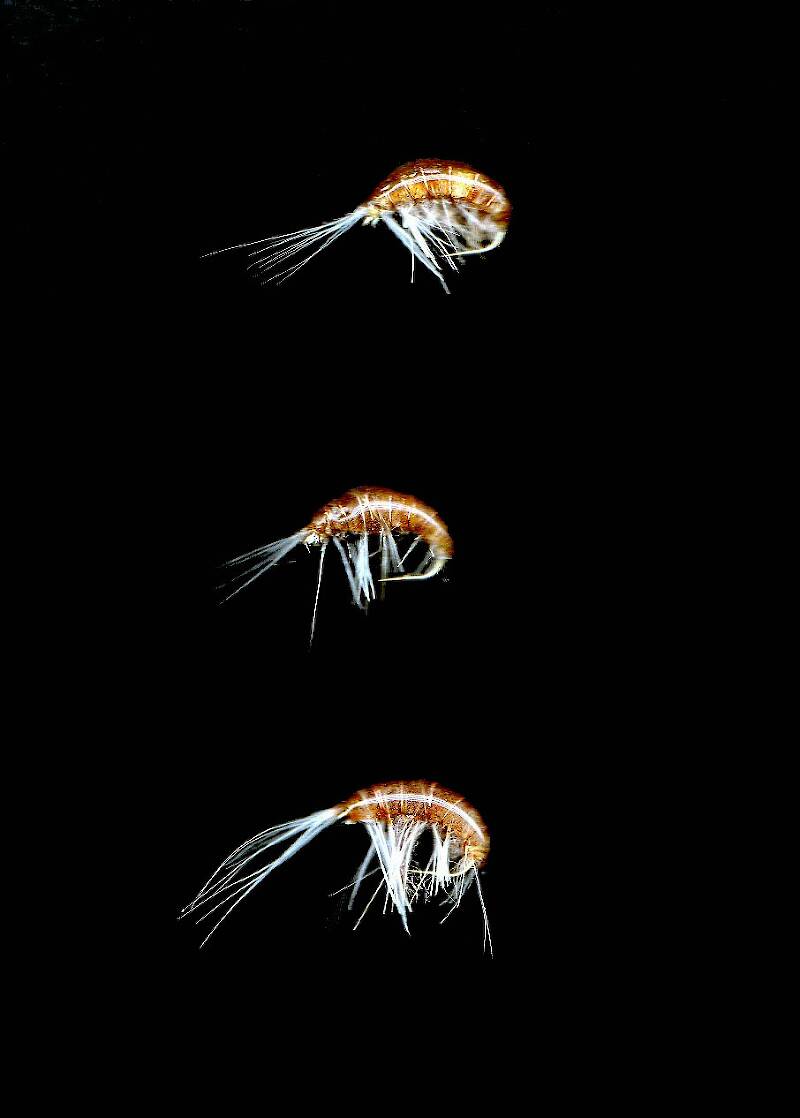
Entoman on Feb 13, 2012February 13th, 2012, 9:19 am EST
Perhaps a strip of lead along one side to further enhance instability and erratic movement?
"It's not that I find fishing so important, it's just that I find all other endeavors of Man equally unimportant... And not nearly as much fun!" Robert Traver, Anatomy of a Fisherman
Entoman on Feb 13, 2012February 13th, 2012, 9:21 am EST
The duck flank barbules. For lack of a better name I called it a wing.
"It's not that I find fishing so important, it's just that I find all other endeavors of Man equally unimportant... And not nearly as much fun!" Robert Traver, Anatomy of a Fisherman
PaulRoberts on Feb 13, 2012February 13th, 2012, 10:00 am EST
I omit those. I'm not tying a Bird's Nest. Just trying to give a visual. This weightless scud is a great opportunity to look at what causes a hook to "right itself". The scud tie I used back in those streams in NY was most simply dubbing on a hook, but since a scud is pretty much tail-less I had to find other ways to right the hook. Whether the fish care or not was another matter; It bugged me.
This might be less important with scuds since as others mention, scuds can swim every which way, and may be apt to be tumbled about if exposed to much current. But crustaceans are darn good swimmers, and they find their way back into cover pretty quickly. The large gray Gammarus I found in my fertile farmland streams back in NY would stretch out and swim in a streaming manner, with some stuttering when accelerating. They also rocked side to side. I've been able to mimic that pretty well -in a bathtub, and on a bluegill pond. Remains to be seen in stream fishing conditions.
Hooks like to ride upside down. Next they like to ride on their side. It takes specific things to right them -if that's what you want.
Weight can stabilize things -including certain instable motions. It takes very little to destabilize an unweighted fly, but not necessarily in a controlled way. It's much easier to stabilize conventional lures bc they are so heavy to begin with. I'll post some things on my attempts at swimming flies, if people are interested. But it won't be right away.
This might be less important with scuds since as others mention, scuds can swim every which way, and may be apt to be tumbled about if exposed to much current. But crustaceans are darn good swimmers, and they find their way back into cover pretty quickly. The large gray Gammarus I found in my fertile farmland streams back in NY would stretch out and swim in a streaming manner, with some stuttering when accelerating. They also rocked side to side. I've been able to mimic that pretty well -in a bathtub, and on a bluegill pond. Remains to be seen in stream fishing conditions.
Perhaps a strip of lead along one side to further enhance instability and erratic movement?
Hooks like to ride upside down. Next they like to ride on their side. It takes specific things to right them -if that's what you want.
Weight can stabilize things -including certain instable motions. It takes very little to destabilize an unweighted fly, but not necessarily in a controlled way. It's much easier to stabilize conventional lures bc they are so heavy to begin with. I'll post some things on my attempts at swimming flies, if people are interested. But it won't be right away.
Entoman on Feb 14, 2012February 14th, 2012, 12:39 am EST
Paul-
I think we've crossed purposes a bit (my fault). I was extrapolating your comments on hook design and how they behave into an idea about tying a new stillwater Bird's Nest variation. Especially your comments about tiny jig hooks (which I'm still fuzzy about). Thinking out loud, so to speak. Coupled with the fact that we both posted at the same time (at least once), we only added to the misunderstanding. I should have picked up on the confusion when you asked about the "wing". Sorry about that! Hope this clears things up and we're back on track. ;) Looking forward to your photos when you can put them up!
Regards,
Kurt
I think we've crossed purposes a bit (my fault). I was extrapolating your comments on hook design and how they behave into an idea about tying a new stillwater Bird's Nest variation. Especially your comments about tiny jig hooks (which I'm still fuzzy about). Thinking out loud, so to speak. Coupled with the fact that we both posted at the same time (at least once), we only added to the misunderstanding. I should have picked up on the confusion when you asked about the "wing". Sorry about that! Hope this clears things up and we're back on track. ;) Looking forward to your photos when you can put them up!
Regards,
Kurt
"It's not that I find fishing so important, it's just that I find all other endeavors of Man equally unimportant... And not nearly as much fun!" Robert Traver, Anatomy of a Fisherman
PaulRoberts on Feb 14, 2012February 14th, 2012, 2:41 am EST
I see. Phew, I was wondering what I was getting myself into.
I used squirrel hair mostly on a 1x or 2x nymph hook unweighted in the design you see in the image I posted. It's designed to ride point-down. I'll buzz one up after I dig out of my present work load.
As to the tiny jigheads, I both made my own (a "trout jig" mold by Do-It), and purchased them as they are pretty cheap. The smallest I see in my collection is about a 14.
My OP brought up the issue (mine alone maybe) that flies that are not tested in the water can yield some disappointing results in that they actually run upside down. It's just that what we see in hand, and think we are offering, may be different things. This may only be an aesthetic issue, as many upside down flies undoubtedly catch fish. But, it bugs me, and had me realizing early on that we assume a lot and that fly designs that look right to fish (trip triggering mechanisms) may be quite different than what we "think" and then see under the warm glow of our tying lamps. The Quigley Cripple exempifies a fly designed for fish in water. Just in hand one might be apt to blurt, "What the hell is this mess??"
Here's what I believe is a good example of a nymph designed in the wrong atmosphere:

Beautiful work of art. And I bet it'll catch fish (as trout spend much of their time sampling the drift). But, I bet this fly runs upside down. It has to. So, recognizing this, why not correct this and tie it to ride point up? There are real advantages to having the point ride up: stability in proper orientation (which you can play with), and a design that won't snag as easily.
Scuds are a special problem. I had to try to beat it bc it bugged me. Again, it may be largely aesthetic. But it touches on something deeper for me -a misunderstanding of how designs actually look/behave in the water.
I used squirrel hair mostly on a 1x or 2x nymph hook unweighted in the design you see in the image I posted. It's designed to ride point-down. I'll buzz one up after I dig out of my present work load.
As to the tiny jigheads, I both made my own (a "trout jig" mold by Do-It), and purchased them as they are pretty cheap. The smallest I see in my collection is about a 14.
My OP brought up the issue (mine alone maybe) that flies that are not tested in the water can yield some disappointing results in that they actually run upside down. It's just that what we see in hand, and think we are offering, may be different things. This may only be an aesthetic issue, as many upside down flies undoubtedly catch fish. But, it bugs me, and had me realizing early on that we assume a lot and that fly designs that look right to fish (trip triggering mechanisms) may be quite different than what we "think" and then see under the warm glow of our tying lamps. The Quigley Cripple exempifies a fly designed for fish in water. Just in hand one might be apt to blurt, "What the hell is this mess??"
Here's what I believe is a good example of a nymph designed in the wrong atmosphere:

Beautiful work of art. And I bet it'll catch fish (as trout spend much of their time sampling the drift). But, I bet this fly runs upside down. It has to. So, recognizing this, why not correct this and tie it to ride point up? There are real advantages to having the point ride up: stability in proper orientation (which you can play with), and a design that won't snag as easily.
Scuds are a special problem. I had to try to beat it bc it bugged me. Again, it may be largely aesthetic. But it touches on something deeper for me -a misunderstanding of how designs actually look/behave in the water.
Entoman on Feb 14, 2012February 14th, 2012, 2:58 am EST
Excellent post, Paul!
So many great points that I can't address them all in a post less then article length. Suffice to say that there are at least 4 or 5 worthy of separate discussion encapsulated in it.
So many great points that I can't address them all in a post less then article length. Suffice to say that there are at least 4 or 5 worthy of separate discussion encapsulated in it.
"It's not that I find fishing so important, it's just that I find all other endeavors of Man equally unimportant... And not nearly as much fun!" Robert Traver, Anatomy of a Fisherman
PaulRoberts on Feb 14, 2012February 14th, 2012, 3:20 am EST
Including the next level of fly-tying...
Now, I have to turn my attention back to earning a living, when I'd just love to sit down at the vise over there on the other side of my office.
Now, I have to turn my attention back to earning a living, when I'd just love to sit down at the vise over there on the other side of my office.
Entoman on Feb 14, 2012February 14th, 2012, 3:31 am EST
:)
"It's not that I find fishing so important, it's just that I find all other endeavors of Man equally unimportant... And not nearly as much fun!" Robert Traver, Anatomy of a Fisherman
Feathers5
Posts: 287
Posts: 287
Feathers5 on Feb 14, 2012February 14th, 2012, 4:15 am EST
Ok, I'll ask the question as nobody has, how do you know a nymph is riding right side up when it's down in the water, and how do you tie it that is does so? I've heard of tying in the round, but I don't know....
Bruce
Bruce
PaulRoberts on Feb 14, 2012February 14th, 2012, 5:49 am EST
Bruce, read the whole thread. It's where the materials are placed on the hook. They are then tested in a bathtub to give a general idea of how stable the fly is.
Feathers5
Posts: 287
Posts: 287
Feathers5 on Feb 14, 2012February 14th, 2012, 6:48 am EST
Hi Paul, I read the bathtub part, but how does the placement of materials keep the fly upright? How are the materials placed on the hook to do just that?
I'm not being a smart a--. I'm serious.
Bruce
I'm not being a smart a--. I'm serious.
Bruce
PaulRoberts on Feb 14, 2012February 14th, 2012, 7:30 am EST
Hi Bruce,
A bare hook, on its own, will ride upside down (point up) when tethered and dragged through the water. Adding a tail, which adds drag behind like fletching on an arrow, causes the hook point to ride point down –the way we generally design our flies and the way think our flies run when we fish them. The same, or additional stability, can be added by moving materials that cause turbulence to the top of the shank (provided you want the fly to ride point down). At the same time, a smooth slick underbelly allows clean passage of water (laminar flow), compared to soft materials that create turbulence and lift –like how an airplane or bird's wing creates lift (viewed in cross-section).
See the image of the scud tie I posted and you'll see it is relatively smooth on bottom and all turbulence producing material is on top. This rights the fly.
In fact, here it is, labelled:

[EDIT]: More tail DOES NOT necessarily stabilize a weighted shank, unless it is tied in above the plane of the shank. The best way to right a hook (or control point orientation) is by keeping turbulence (“wings”, tails, picked dubbing, what have you) up top, above the plane of the shank.
With a jig head, or bead head, it might be impossible to get the fly to ride point down in the conventional manner. They ride hook up.
Now look at the super snazzy nymph image I posted. Do you think it will ride oriented the way the tier intended? It has all the elements in place to make a very stable running fly -hook point up.
A bare hook, on its own, will ride upside down (point up) when tethered and dragged through the water. Adding a tail, which adds drag behind like fletching on an arrow, causes the hook point to ride point down –the way we generally design our flies and the way think our flies run when we fish them. The same, or additional stability, can be added by moving materials that cause turbulence to the top of the shank (provided you want the fly to ride point down). At the same time, a smooth slick underbelly allows clean passage of water (laminar flow), compared to soft materials that create turbulence and lift –like how an airplane or bird's wing creates lift (viewed in cross-section).
See the image of the scud tie I posted and you'll see it is relatively smooth on bottom and all turbulence producing material is on top. This rights the fly.
In fact, here it is, labelled:

[EDIT]: More tail DOES NOT necessarily stabilize a weighted shank, unless it is tied in above the plane of the shank. The best way to right a hook (or control point orientation) is by keeping turbulence (“wings”, tails, picked dubbing, what have you) up top, above the plane of the shank.
With a jig head, or bead head, it might be impossible to get the fly to ride point down in the conventional manner. They ride hook up.
Now look at the super snazzy nymph image I posted. Do you think it will ride oriented the way the tier intended? It has all the elements in place to make a very stable running fly -hook point up.
Entoman on Feb 14, 2012February 14th, 2012, 12:00 pm EST
Nice graphics, Paul!
BTW - the last sentence... Yep! As is the case with most store-boughts nowadays. I guess since 99% of 'em just dangle under an indicator, it doesn't matter much. The art of subtly moving the fly seems to be less and less practiced these days.
Bruce - it's all about resistance. A fly sinking upside down because it has a smooth back with a bunch of stuff sticking out underneath is like descending to earth under a parachute. Same principle...
To check out your flies - a tub is good, but a swimming pool or clear pond nearby is even better.
BTW - the last sentence... Yep! As is the case with most store-boughts nowadays. I guess since 99% of 'em just dangle under an indicator, it doesn't matter much. The art of subtly moving the fly seems to be less and less practiced these days.
Bruce - it's all about resistance. A fly sinking upside down because it has a smooth back with a bunch of stuff sticking out underneath is like descending to earth under a parachute. Same principle...
To check out your flies - a tub is good, but a swimming pool or clear pond nearby is even better.
"It's not that I find fishing so important, it's just that I find all other endeavors of Man equally unimportant... And not nearly as much fun!" Robert Traver, Anatomy of a Fisherman
PaulRoberts on Feb 14, 2012February 14th, 2012, 1:07 pm EST
Ha! I couldn't make nice little curved arrows for the turbulence. Oh well.
The only time I ever get to "hang" a fly "under" an indicator is on very slow water. Otherwise, the rod tip, line, or indicator are leading the fly.
The only time I ever get to "hang" a fly "under" an indicator is on very slow water. Otherwise, the rod tip, line, or indicator are leading the fly.
Martinlf on Feb 14, 2012February 14th, 2012, 1:43 pm EST
This is turning into a very interesting thread. In addition to forces of lift and drag, I believe that the laws of physics suggest that adding lighter materials, such as dubbing and hackle evenly to the shank of a standard streamer or nymph hook would cause the shank to suspend somewhat more than the heavier and thinner bend and point wire which would then swing down under the shank. Also I would think that a ring or up eye vs. a turned down eye would play a part in all of this once a tippet is attached and tension occurs. A down eye would seem to exert some twisting pressure to invert the hook, unless a turle or Harvey knot was used. Ultimately, though, the orientation of the hook would all depend on how much force these and other elements mentioned (and thus far ignored) exert.
I'm sure Paul is right about weighted scud hooks. In fact I tie a number of my weighted mayfly nymphs Frenchie style (simple and in the round) on scud hooks and intend them to ride point up to avoid snagging and dulling on bottom structures. Some fish, at least, have given their approval. If I add a wingcase, it goes on the inside of the bend, so it will be oriented up in the water. I also tie a popular PA fly, the Walt's Worm, the same way much of the time, as well as a number of other similar in-the-round flies.
I'm sure Paul is right about weighted scud hooks. In fact I tie a number of my weighted mayfly nymphs Frenchie style (simple and in the round) on scud hooks and intend them to ride point up to avoid snagging and dulling on bottom structures. Some fish, at least, have given their approval. If I add a wingcase, it goes on the inside of the bend, so it will be oriented up in the water. I also tie a popular PA fly, the Walt's Worm, the same way much of the time, as well as a number of other similar in-the-round flies.
"He spread them a yard and a half. 'And every one that got away is this big.'"
--Fred Chappell
--Fred Chappell
PaulRoberts on Feb 14, 2012February 14th, 2012, 2:31 pm EST
I can only imagine the new bath toys we'll all be enjoying.
Shawnny3 on Feb 14, 2012February 14th, 2012, 3:06 pm EST
I generally try to find ways to get my scuds to track shell back up as much as possible. Does anyone have any other tips to accomplish this?
Foam. If that doesn't work, use more foam. Lots and lots of foam.
-Shawn
P.S. In all seriousness, this has been a very interesting thread. Thank you for the insights and photos, guys - some really good stuff.
Jewelry-Quality Artistic Salmon Flies, by Shawn Davis
www.davisflydesigns.com
www.davisflydesigns.com
Martinlf on Feb 14, 2012February 14th, 2012, 3:16 pm EST
A weighted shank requires more tail
Now there's a point that calls for some serious pondering.
"He spread them a yard and a half. 'And every one that got away is this big.'"
--Fred Chappell
--Fred Chappell
PaulRoberts on Feb 15, 2012February 15th, 2012, 5:32 pm EST
Louis, you’ve got me wondering... Originally, I didn’t test a lot of variables on bare hooks, just enough to start thinking about and experimenting with hook balance and “lift”. So, I re-ran my original test (a bare long shank hook with and without a tail) and then some of the other variables: shank length, eye orientation, and weighting.
Hypotheses:
1). A bare hook, on its own, will ride upside down (point up) when tethered and dragged through the water.
2). A tail will right the hook to point down orientation.
3). Weighting the shank requires more tail to right the hook.
Results and Discussion of Variables
Tippet Diameter:
Tippet diameter can mask the normal balance of the bare hook in water. A stiff tippet can be rotated in the fingers which can re-orient the hook up, down, or to one side, depending on how your fingers are holding it. A long length of fine tippet alleviates this effect. I also tried to hold the tippet low to the water surface to better mimic our fishing. The tippets appeared to become more supple as they became soaked.
To lessen tippet effects I used 5X with #6 hooks, and 7X with #14 hooks –combinations we wouldn’t likely fish with.
Shank Length:
Bare 3X long shanks (9672) rode point up in a rather stable fashion.
Bare 1X short shank length hooks (3906) were apt to ride point down, with shank tilted at about 45deg angle with the bend down and eye up. They were less stable than the long shank though, apt to flip onto their sides, esp so with a coarser tippet, even to rotate which ever way the tippet twisted.
Line tie:
Where the knot was situated in these down-eye hooks mattered more with the shorter hook. On the long shank hook knot location didn't re-orient the point from point up. On the short hook though, knotting it high and in line with the shank and the point orientation was less stable, more apt to turn to one side. Pull the knot down low on the down-eye and the hook ran point down but steeply angled upwards -eye up and bend down.
Adding Tails:
Adding an ample tail to the long shank hook caused it to ride point down in a fairly stable fashion, esp so if the tail is tied up high at the top of the bend. In fact, the further up the shank you creep, the more stable the point orientation becomes.
Adding an ample tail to a short hook (3906) didn’t make as much difference as with the long shank, and the tail HAD to be placed above the bend to bolster the point down orientation. Interestingly, just a tiny ball of thread and fluff just above the bend on the top of the shank, (I simply cut the tail off leaving the thread and tail butt fibers), stabilized the upright posture of the hook nicely.
Weighting:
Weighting the length of the shank of the bare long hook caused it to lose some stability. And where the knot was situated in the line tie mattered a lot. Pull it low on the tip of the down-eye and the hook flipped stably point up, like a jig. Where the weight was placed on the shank top or bottom mattered little.
Weighting the short hook caused it too to ride point up, but was less stable than the long-shank, and more apt to be affected by the tippet. Again, knot location on the eye mattered as in the long shank.
Adding tails had less of an effect against weighting than I’d thought. And again, was most effective if tied high up at the top of the bend.
Joe Humphrey’s states that weighting on the forward third of the shank, and flattening the lead, gets his 2x (9671) to run 45deg eye up (like my unweighted short hooks did). He also said that it rocks (or flips) to the side some too –also like my unweighted ones did. Instability I suppose.
Wet fly:
I then chose a #6 (3906) tail-less, dubbed-bodied, hen-hackled wet-fly and dragged it around in the tub, finding that it ran a lot like the bare hook: point down although a bit more stable, but apt to twist some when sped up. I then trimmed away the underneath hackle fibers, leaving hackle only on the sides and top and the fly fully stabilized point down. I could accelerate it, jerk it, twitch it, and it remained stable.
So… in conclusion:
It appears tails only offer good stability on hooks when they are tied high up on the bend, bringing the material above the plane of the shank. Long shank hooks were more readily stabilize by the addition of a tail. In general, reserving turbulence for the top of the fly garners the greatest stability.
I've edited my post above to correct my incomplete thoughts about the effect of tails.
Hypotheses:
1). A bare hook, on its own, will ride upside down (point up) when tethered and dragged through the water.
2). A tail will right the hook to point down orientation.
3). Weighting the shank requires more tail to right the hook.
Results and Discussion of Variables
Tippet Diameter:
Tippet diameter can mask the normal balance of the bare hook in water. A stiff tippet can be rotated in the fingers which can re-orient the hook up, down, or to one side, depending on how your fingers are holding it. A long length of fine tippet alleviates this effect. I also tried to hold the tippet low to the water surface to better mimic our fishing. The tippets appeared to become more supple as they became soaked.
To lessen tippet effects I used 5X with #6 hooks, and 7X with #14 hooks –combinations we wouldn’t likely fish with.
Shank Length:
Bare 3X long shanks (9672) rode point up in a rather stable fashion.
Bare 1X short shank length hooks (3906) were apt to ride point down, with shank tilted at about 45deg angle with the bend down and eye up. They were less stable than the long shank though, apt to flip onto their sides, esp so with a coarser tippet, even to rotate which ever way the tippet twisted.
Line tie:
Where the knot was situated in these down-eye hooks mattered more with the shorter hook. On the long shank hook knot location didn't re-orient the point from point up. On the short hook though, knotting it high and in line with the shank and the point orientation was less stable, more apt to turn to one side. Pull the knot down low on the down-eye and the hook ran point down but steeply angled upwards -eye up and bend down.
Adding Tails:
Adding an ample tail to the long shank hook caused it to ride point down in a fairly stable fashion, esp so if the tail is tied up high at the top of the bend. In fact, the further up the shank you creep, the more stable the point orientation becomes.
Adding an ample tail to a short hook (3906) didn’t make as much difference as with the long shank, and the tail HAD to be placed above the bend to bolster the point down orientation. Interestingly, just a tiny ball of thread and fluff just above the bend on the top of the shank, (I simply cut the tail off leaving the thread and tail butt fibers), stabilized the upright posture of the hook nicely.
Weighting:
Weighting the length of the shank of the bare long hook caused it to lose some stability. And where the knot was situated in the line tie mattered a lot. Pull it low on the tip of the down-eye and the hook flipped stably point up, like a jig. Where the weight was placed on the shank top or bottom mattered little.
Weighting the short hook caused it too to ride point up, but was less stable than the long-shank, and more apt to be affected by the tippet. Again, knot location on the eye mattered as in the long shank.
Adding tails had less of an effect against weighting than I’d thought. And again, was most effective if tied high up at the top of the bend.
Joe Humphrey’s states that weighting on the forward third of the shank, and flattening the lead, gets his 2x (9671) to run 45deg eye up (like my unweighted short hooks did). He also said that it rocks (or flips) to the side some too –also like my unweighted ones did. Instability I suppose.
Wet fly:
I then chose a #6 (3906) tail-less, dubbed-bodied, hen-hackled wet-fly and dragged it around in the tub, finding that it ran a lot like the bare hook: point down although a bit more stable, but apt to twist some when sped up. I then trimmed away the underneath hackle fibers, leaving hackle only on the sides and top and the fly fully stabilized point down. I could accelerate it, jerk it, twitch it, and it remained stable.
So… in conclusion:
It appears tails only offer good stability on hooks when they are tied high up on the bend, bringing the material above the plane of the shank. Long shank hooks were more readily stabilize by the addition of a tail. In general, reserving turbulence for the top of the fly garners the greatest stability.
I've edited my post above to correct my incomplete thoughts about the effect of tails.
Gutcutter on Feb 16, 2012February 16th, 2012, 4:20 pm EST
Wow
Very, very interesting. Thanks, Paul
Tony
Very, very interesting. Thanks, Paul
Tony
All men who fish may in turn be divided into two parts: those who fish for trout and those who don't. Trout fishermen are a race apart: they are a dedicated crew- indolent, improvident, and quietly mad.
-Robert Traver, Trout Madness
-Robert Traver, Trout Madness
Quick Reply
Related Discussions
Topic
Replies
Last Reply
1
Aug 22, 2013
by Sayfu
by Sayfu
Re: Help to get some specimens of the isopod Caecidotea communis
In the Arthropod Family Asellidae by Leonardo
In the Arthropod Family Asellidae by Leonardo
11
Mar 29, 2013
by Leonardo
by Leonardo
4
Nov 14, 2015
by Oldredbarn
by Oldredbarn





